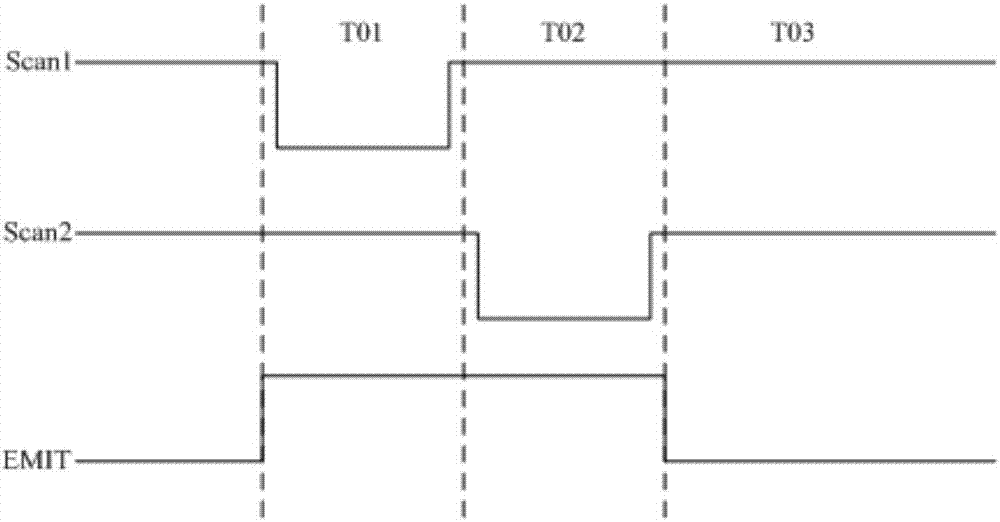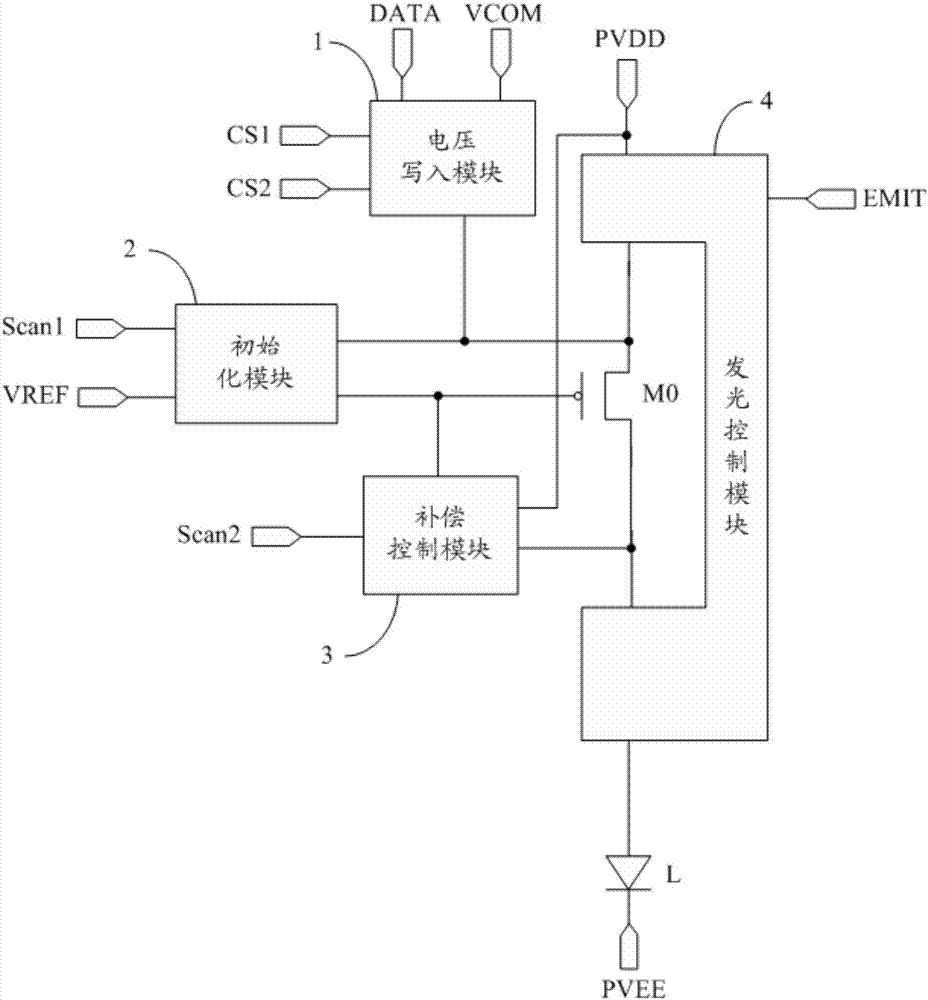Pixel circuit, driving method of pixel circuit, organic light-emitting display panel and display device
A pixel circuit and light-emitting device technology, applied in circuits, electrical components, static indicators, etc., can solve problems such as inconsistent brightness of the first frame, and achieve the effects of avoiding afterimage phenomenon, avoiding parasitic capacitance, and reducing writing time
- Summary
- Abstract
- Description
- Claims
- Application Information
AI Technical Summary
Problems solved by technology
Method used
Image
Examples
Embodiment 1
[0114] by Figure 4A Take the pixel circuit shown as an example, and the corresponding input timing diagram is as follows Figure 6A shown. Specifically, the main selection of Figure 6A The four stages T1, T2, T3 and T4 in the input timing diagram shown.
[0115] In the T1 stage, Scan1=0, CS1=1, CS2=1, Scan2=1, EMIT=1.
[0116] Since Scan1=0, the fourth transistor M4 is turned on and provides the reference voltage signal to the first node N1 and the second node N2, so that the voltages of the first node N1 and the second node N2 are both the voltage V of the reference voltage signal ref , to initialize the control electrode M0 and the first electrode of the driving transistor M0. Since CS1=1, the first transistor M1 is turned off. Since CS2=1, the second transistor M2 is turned off. Since Scan2=1, the fifth transistor M5 is turned off. Since EMIT=1, both the sixth transistor M6 and the seventh transistor M7 are turned off, and the light emitting device L does not emit ...
Embodiment 2
[0125] by Figure 4D Take the pixel circuit shown as an example, and the corresponding input timing diagram is as follows Figure 6B shown. Specifically, the main selection of Figure 6B The four stages T1, T2, T3 and T4 in the input timing diagram shown.
[0126] In the T1 stage, Scan1=0, CS1=1, Scan2=1, EMIT=1.
[0127] Since Scan1=0, the fourth transistor M4 is turned on and provides the reference voltage signal to the first node N1 and the second node N2, so that the voltages of the first node N1 and the second node N2 are both the voltage V of the reference voltage signal ref , to initialize the control electrode M0 and the first electrode of the driving transistor M0. Since CS1=1, the first transistor M1 is turned off, and the second transistor M2 is turned on. Since Scan2=1, both the third transistor M3 and the fifth transistor M5 are turned off. Since EMIT=1, both the sixth transistor M6 and the seventh transistor M7 are turned off, and the light emitting device ...
Embodiment 3
[0136] by Figure 5A Take the pixel circuit shown as an example, and the corresponding input timing diagram is as follows Figure 6C shown. Specifically, the main selection of Figure 6C The four stages T1, T2, T3 and T4 in the input timing diagram shown. and Figure 6C In Scan3_1 represents Figure 5A The signal of the third scan signal terminal Scan3 in the pixel circuit shown.
[0137] In the T1 phase, since Scan3_1=0, the eighth transistor M8 is turned on and provides the reference voltage signal to the first terminal of the light-emitting device L, so as to reset the light-emitting device L, so as to avoid the problem of light emission in the previous frame and light emission in the current frame. influences. In the T2-T4 phase, since Scan3_1=1, the eighth transistor M8 is turned off. The working processes of the other transistors are basically the same as those of the transistors in the T1-T4 phases in the first embodiment, and will not be repeated here.
[0138]...
PUM
 Login to View More
Login to View More Abstract
Description
Claims
Application Information
 Login to View More
Login to View More - R&D
- Intellectual Property
- Life Sciences
- Materials
- Tech Scout
- Unparalleled Data Quality
- Higher Quality Content
- 60% Fewer Hallucinations
Browse by: Latest US Patents, China's latest patents, Technical Efficacy Thesaurus, Application Domain, Technology Topic, Popular Technical Reports.
© 2025 PatSnap. All rights reserved.Legal|Privacy policy|Modern Slavery Act Transparency Statement|Sitemap|About US| Contact US: help@patsnap.com



